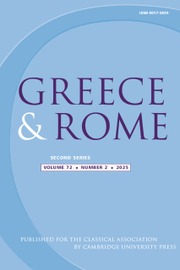No CrossRef data available.
Article contents
More Beasts from Herodotos: An Essay by a Schoolgirl
Published online by Cambridge University Press: 05 January 2009
Extract
The bird I am going to write about is the owl. The owl cannot see at all in the daytime, and at night it is as blind as a bat. I do not know much about the owl, so I will go on to the beast I am going to choose. It is the cow. The cow is a marnai, and it is tame. It has six sides, right, left, fore, back and upper and below. At the back it has a tail, on which hangs a brush. With this it sends the flies away, so that they do not fall into the milk. The head is for the purpose of growing horns, and so that the mouth can be somewhere. The horns are to butt with. The mouth is to moo with. Under the cow hangs the milk. It is arranged for milking. When people niilk, the milk comes, and there is never any end to the supply. How the cow does it I have not yet realized, but it makes more and more. The man cow is called an ox, but what it eats it eats twice, so that it gets enough. When it is hungry it moos, and when it says nothing, it is because its inside is full up of grass.
- Type
- Research Article
- Information
- Copyright
- Copyright © The Classical Association 1964


